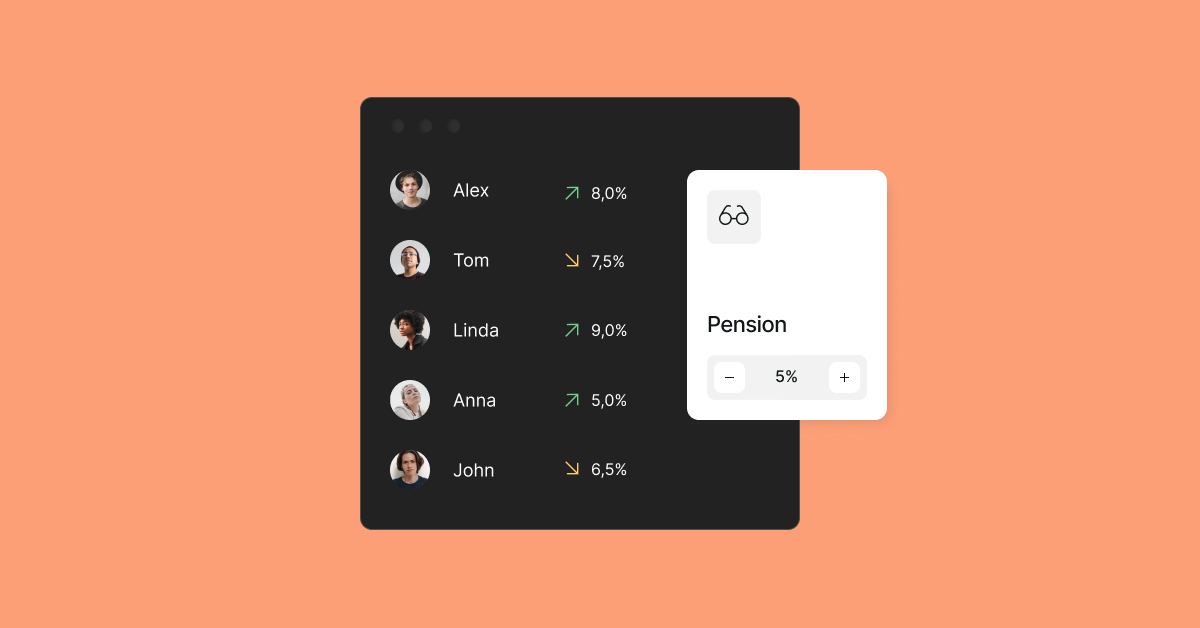The employer’s guide to pension contributions

When it comes to workplace pensions, employers need to keep on top of their legal obligations, salary deductions, employer contributions and ensure that their payroll software is fully integrated and up to date. Understanding your responsibilities in relation to different types of employees, giving employees the choice to change contributions when they like, deducting employer pension contributions accordingly and keeping payroll and pension provider in sync can be an unwanted administrative headache and a constant source of human error. This article walks employers through everything they need to know about pension contributions in the UK.
What is a workplace pension scheme?
A workplace pension scheme is a means for employees to save for their retirement that is arranged by their employer. They can also be referred to as ‘occupational’, ‘works’, ‘company’ or ‘work-based’ pensions. Workplace pension schemes are mandatory for every employer in the UK.
How does a workplace pension scheme work?
A portion of eligible employees’ salaries is automatically deducted by their employer and put into their pension pot. Employers are also legally obliged to contribute a certain amount to their employees’ pension schemes.
Types of pension
Before we look in detail at workplace pension schemes from an employer’s perspective, it’s worth outlining the different types of pension schemes. When choosing between schemes, consider factors such as cost, tax relief methods, payroll compatibility, and whether the scheme in question will accept your staff.
Choosing a workplace pension scheme
It’s advisable for employers to take the time to choose a workplace pension scheme that serves them and their employees well. The most important factor is that your chosen pension scheme is set up for automatic enrolment. This means that it cannot have any joining conditions or requirements for members to select their own investments, and ensures you are complying with pension regulations.
Employers should also check that their company is eligible to join certain schemes, since some pension providers stipulate a minimum number of employees or certain earnings which may not cover all of your workforce.
Finally, employers should confirm which tax relief method a particular scheme uses: relief at source or net pay arrangements. Since pension providers can only use one method and this will have a different impact on lower and higher earning staff, employers need to determine which type of tax relief will, on balance, better serve their particular workforce profile.
Should I choose a net pay or relief at source scheme?
For auto enrolment workplace pension there are two ways how deductions can be calculated. You should choose which one is most suitable for your employees before making a decision which pension provider you pick, as many providers support either one or the other.
Net Pay
Income tax is calculated after pension contributions have been deducted. This means that the employee pay less tax. Smart Pension is a popular pension platform for Net Pay.
Relief at Source
The government ‘tops up’ employee contributions by 25% so that 80% of the total employee contributions are provided by the employee and 20% by the state. However, relief at source means that the employee does not save on income tax. Nest is a popular pension platform for Relief at Source.
At a high level, relief at source works well for employees with effective income below c. £63,000 per annum. Below that income level, the effective income tax rate is under 20%, meaning that the government top up to the contributions is higher than the tax savings the employee would have in a net pay scheme.
Net pay works best for employees with over 20% effective income tax rate, i.e. annual incomes of £63,000 or higher, at which point the income tax savings are more attractive than the government top up to contributions.
What about Salary Sacrifice pensions?
Though all pension contributions (up to the threshold) are eligible for tax relief, they are not exempt from National Insurance Contributions. Some employers choose to roll-out a salary sacrifice or salary exchange scheme in which employees agree to ‘sacrifice’ a set portion of their salary to their pension.
What is the point you may ask? The benefits of sacrificing salary is that it effectively reduces income subject to national insurance contributions, thus resulting in higher take home salaries for employees and a lower NIC bill for the employer, a win-win for both.
Note, Salary Sacrifice schemes do not comply with auto enrolment and employers cannot force employees to join this kind of scheme. To fulfill your pension obligations you must keep an auto-enrolment scheme as the default. However, you can run a Salary Sacrifice scheme in parallel for employees to opt into if they wish.
Defined contribution pensions
In a defined contribution pension (also called ‘money purchase’ schemes), employer and employee contributions are invested in publicly traded assets such as stocks or bonds. This type of pension pot is based on how much is put into it and is the market standard type of pension. The value of the pension can fluctuate and change, depending on the success of the investments.
When the employee reaches retirement age, they can choose to access their funds in different ways: through drawdown pensions, buying an annuity or taking a scheme pension.
Defined benefit pensions
This is a pension pot that is based on your earnings and the length of time that an employee has worked for you. They can also be referred to as ‘final salary’ or ‘career average’ pension schemes.
The amount that an employee gets when they retire are defined by the pension scheme’s rules rather than how the investments have performed or their total lifetime contributions.. Note however, that defined benefit pensions are relatively rare these days because of the higher risk they pose for employers, as they have to bear the risk of market performance.
Who needs to be enrolled in workplace pension schemes?
Under the Pensions Act 2008, all employers are obliged to provide a workplace pension scheme for all eligible staff as soon as their first member of staff starts working for them. This is called the ‘duties start date’.
Employers must automatically enrol staff in their workplace pension scheme what is considered eligible employees, i.e. who meet the following criteria:
- Classified as ‘workers’
- Aged between 22 and the State Pension age
- Earn £10,000 per year or more
- Usually work in the UK
If an employee earns below £520 a month, employers do not need to contribute to their pensions.
How does automatic enrolment work?
As we said above, automatic enrolment duties begin as soon as you hire your first employee (duties start date). Remember, it is not a one-time legal duty but an ongoing responsibility. Ensure to keep track of any changes in age or earnings within your workforce, as these may trigger automatic enrolment for another member of staff.
When choosing a pension scheme, employers must ensure that their chosen scheme is compatible with automatic enrolment.
Once you’ve chosen your pension scheme and identified which employees are eligible for automatic enrolment, you need to inform them in writing that they’ve been automatically enrolled in a workplace pension scheme.
Employers must let their employees know when they were enrolled, the type of pension scheme, the value of the employer and employee contributions, how they can leave the scheme, and any relevant information regarding tax relief.
In the majority of automatic enrolment schemes, employees will contribute based on their qualifying earnings (earnings between £6,240 and £50,270 a year) before tax, see more about this below.
Any employees that are not eligible for automatic enrolment can choose to ‘opt-in’ to their workplace pension scheme.
Employers’ pension schemes & responsibilities
Demonstrate compliance & Re-enrolment
Employers must also declare their compliance within 5 months of their duties start date. And every three years, you need to carry out ‘re-enrolment’ to re-enrol any employees who may have left your workplace pension scheme as well as re-declare your compliance.
Join requests
Employers must correspond with any employees that weren’t eligible for automatic enrolment, informing them that they can choose to opt-in to the workplace pension scheme anyway. You must enrol staff who write to you requesting to join. You need to do this within a month of first receiving their joining request.
Administration and Record Keeping
Lastly, employers have certain administrative and record-keeping duties. These include keeping records of:
- Names and addresses of everyone enrolled in your workplace pension scheme
- Payment records detailing when and how much was paid into your scheme
- Joining or leaving requests
- Pension scheme reference/registry number
Employers must retain these records for a minimum of six years (with the exception of requests to leave which need to be retained for four years). This is important because it first makes sure that any contributions made are correct and also acts as evidence should a dispute arise.
When do employers need to pay pension contributions?
You must ensure to pay pension contributions on time. You should agree payment deadlines directly with your pension trustee or providers.
There is a legal requirement that once employers deduct the relevant contribution from their employees’ salaries, they must pay it by the 22nd day of the following month (or the 19th if paying by cheque).
How are total earnings calculated for pension contributions?
Total earnings are calculated by looking at:
- Salary
- Bonuses and commission
- Overtime payment
- Statutory sick pay
- Statutory maternity, paternity or adoption pay
How much are employer pension contributions UK?
The value of pension contributions differs depending on the type of pension scheme as well as if the employer is running an automated enrolment scheme or ‘opt-in’ system. Employers must deduct from their employees’ salaries and pay this into their pension scheme alongside their own contributions accurately and on time. Late or inaccurate payment could result in a fine from the Pensions Regulator.
What is the minimum employer contribution for automatic enrolment?
Though specific pension schemes may stipulate their own minimum contributions, the UK government has also set a national requirement. The total minimum contribution is 8% (with 5% staff contribution), so the minimum an employer has to contribute is 3% (since 6 April 2019).
Depending on the workplace pension scheme, the minimum contribution may be higher (as is the case for a lot of defined benefit pension schemes). Employers can also choose to pay more than the minimum requirement.
If you have members of staff who become eligible after changes to their earnings (or when their birthday comes), you’re required to enrol them immediately and inform them in writing within 6 weeks of the date that they become eligible. This is taken care of automatically with Zelt’s pension management app, as it keeps track of employee’s age and compensation and reassesses all active employees continuously.
You don’t need to enrol any employees that are able to show you evidence of their ‘lifetime allowance protection’.
How to calculate qualifying earnings
For the tax year 22/23, the qualifying earnings for workplace pension schemes are all earnings between the following thresholds:
- Lower threshold: £6,240 per year (£520 a month)
- Upper threshold: £50,270 per year (£4,189 per month)
For example, an annual income of 30,000 amounts to qualifying earnings of £23,760 and any income above £50,270 amounts to qualifying earnings of £44,030.
Opt-in & voluntary joining
Employees can opt in to a workplace pension scheme if they are:
- Aged between 16-21, or state pension age – 74
- Earn above £833 a month
Or
- Aged between 16 and 74
- Earn between £520 and £833 a month
Employees can voluntarily join if they are:
- Aged between 16 and 74
- Earn less than £520 a month
The difference between opting in and voluntarily joining is that employers must contribute the statutory minimum amount of employer contributions for employees that opt in to the scheme, but do not have to pay any employer contributions for employees that join voluntarily.
Annual Allowance
Annual allowance is the amount that a person can contribute to their pension fund tax-free every tax year (6th April to 5th April). Beyond this threshold, they will incur a tax charge. Currently the annual allowance is £40,000. However, because of what is known as ‘tapering’ some higher earners may end up with a lower allowance. If someone does not use their allowance in a previous year (up to three years), they may be able to carry this amount forward.
Lifetime allowance
If an individual’s pension pot is worth more than £1,073,100 then they will have to pay tax on it. If they withdraw the money as a lump sum, they will pay 55% tax. If they access their pension pot in a different way then they will pay 25% tax.
Calculating employer pension contribution
Contributions are calculated following a simple formula that can be summarised as follows:
Employer contributions = Qualifying Earnings * 3% (minimum)
Employee contributions = Qualifying Earnings * 5% (minimum)
The below table shows the amount of minimum contributions at different salary levels. You can use this calculator to input more specific figures.
| Annual Salary | Qualifying Earnings | Employer Contribution (3% minimum) | Employee Contribution (5% difference) | Total Minimum Contribution (8% minimum) |
| £20,000 | £13,760 | £413 | £688 | £1,101 |
| £30,000 | £23,760 | £713 | £1,188 | £1,901 |
| £40,000 | £33,760 | £1,103 | £1,688 | £2,701 |
| £50,000 | £43,760 | £1,313 | £2,188 | £3,501 |
| £60,000 | £44,030 | £1,321 | £2,202 | £3,522 |
| £70,000 | £44,030 | £1,321 | £2,202 | £3,522 |
| £80,000 | £44,030 | £1,321 | £2,202 | £3,522 |
| £90,000 | £44,030 | £1,321 | £2,202 | £3,522 |
| £100,000 | £44,030 | £1,321 | £2,202 | £3,522 |
Corporation Tax Relief on Employer Pension Contributions
Employers can get corporation tax relief on any contributions they make to their employees workplace pension scheme. This is because they are categorised as a type of business expense associated with the costs of having employees.
Employer pension contributions are deductible for the accounting period during which they were paid. They cannot be charged retrospectively or in advance.
Complying with pension regulation without using modern software is a big pain point for employers
Many employers spend a considerable amount of effort to get pension contributions right. There are a lot of different factors, legal requirements, and processes to consider. That’s why employers need to ensure their payroll system makes the entire process as straightforward and transparent as possible.
Your payroll system needs to calculate contributions and make the correct deductions from staff pay. It is essential to ensure that your chosen pension scheme is compatible and integrated with your payroll software and that employee are able to join and leave your pension, and make changes to their contributions easily via their employee portal.
It is the employer’s responsibility to correctly input rates of contributions, as well as which employee earnings should be used to calculate their contributions. Employers also need to ensure that relevant and correct information is outlined on employees’ payslips.
Zelt automates workplace pensions for employers and gives control and visibility to employees
In new generation employee platforms like Zelt, all new employees are automatically assessed when they join the company and informed of their rights regarding their workplace pension. Zelt connects to most modern pension providers like Nest and Smart Pension and automatically adds new joiners and removes leavers when you run payroll.
Also, in Zelt, employees can self-serve, meaning they can -depending on their eligibility – opt in or join voluntarily, opt out or leave the scheme, and change their personal contributions whenever they please. Requiring no involvement from the employer, streamlining your processes and saving you time.
Zelt also gives the employee oversight and visibility over their pension savings and choices. Employees get live access to their contribution history, how much they’ve saved and how much they’ll retire with, giving employees more control over their finances and helping them make more informed decisions about their future and financial well-being.
Zelt isn’t just software, it’s a new approach to the workplace. Discover more on our website.
Frequently Asked Questions
What are pension contributions?
Pension contributions are the amount that an employee or employer pays towards the employee’s pension pot.
How to work out workplace pension contributions
As we’ve seen, the amount that an employee and employer contributes to their workplace pension depends on the specific pension scheme. However, there is a legal minimum employee contribution requirement of 5% of total earnings, as well as a minimum employer contribution of 3% total earnings.
What is a pension?
A pension is a pot of money that provides retirement income. There are many different types of pensions: workplace, private and state.
How to claim back tax relief on pension contributions?
Up to the annual allowance, pension contributions are tax-free. This means that the government will deposit money into employees’ workplace pension as a type of ‘tax relief’. Employees will benefit from tax relief if they pay income tax and pay into a workplace (or personal) pension scheme.
When are pension contributions due?
Pension contributions must be paid by the 22nd day of the month after the deduction was made.

